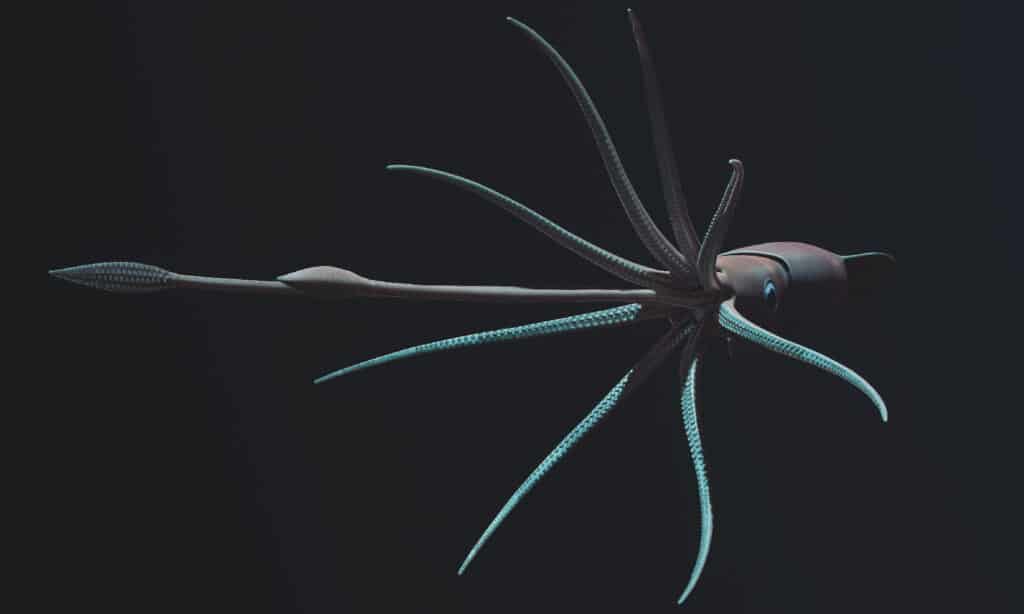One thrives in the deepest, darkest depths of the ocean while the other prefers coastlines and warmer waters. Yet if they were to fight, each has its own offensive capabilities to wield. Discover who emerges victorious in a giant squid vs. hammerhead shark battle!
Comparing a Giant Squid vs. a Hammerhead Shark Battle
| Giant Squid | Hammerhead Shark | |
|---|---|---|
| Size | 33 to 59 feet long; can weigh up to 2,000 pounds | 18 to 20 feet long; can weigh over 1,000 pounds |
| Speed and Movement | Up to 25 miles per hour | Up to 25 miles per hour |
| Defenses | Release of dark, black ink to cloud the water and confuse predators | Aggressive behavior; uses hammerhead to bump; and teeth to bite |
| Offensive Capabilities | Two long feeding tentacles that reach up to 33 feet away; sharp teeth in suckers at the end of tentacles | Sharp, serrated teeth; pinning using hammerhead |
| Predatory Behavior | Lives in the depths of the oceans; surprises prey from below; uses feeding tentacles and beak to slice through food | Stalks and ambushes prey from below; use electrical receptors on the head to sense prey |
What Are the Key Differences Between a Giant Squid and a Hammerhead Shark Battle?
Giant squid and hammerhead sharks don’t typically inhabit the same regions of the ocean. Whereas giant squids are incredibly elusive, delving deep into the ocean’s depths, hammerhead sharks prefer coastlines and staying near the surface of the water. The water temperature drops considerably in the depths, and hammerhead sharks prefer warmer waters. Both sea creatures grow immensely, but giant squids are usually longer and heavier.

Giant squid are elusive creatures.
©InnovationWorld/Shutterstock.com
What Are the Key Factors in a Fight Between a Giant Squid and a Hammerhead Shark Battle?
The size of a giant squid vs. a hammerhead shark plays an important role as each would prefer to avoid the other. They don’t see one another as prey. The speed with which they move also plays a role, as they may choose to flee if they perceive danger. However, because they move at the same speed, neither could outswim the other. Their defenses and offensive capabilities are also key factors that could give them an advantage and the way they hunt could translate to the way they fight with another predator.
Giant Squid vs. Hammerhead Shark Battle: Size
A giant squid is larger than a hammerhead shark. When a hammerhead shark hunts, it doesn’t go for any animal larger than a stingray, which is its preferred source of sustenance. If it were to encounter a giant squid, it would likely have the instinct to create as much distance as possible, being that it would tower over it. However, in a fight, a great hammerhead shark is a worthy opponent.

Giant squid can reach 33 to 59 feet in length and weigh up to 2,000 pounds.
©iStock.com/3dsam79
Giant Squid vs. Hammerhead Shark Battle: Speed and Movement
Both hammerhead sharks and giant squids move at around the same speed of 25 miles per hour. But giant squids have eight tentacles and two feeding tentacles, which allow them to move differently in the water, reaching distances of up to 33 feet with their feeding tentacles. They also use jet propulsion to move in the water whereas hammerhead sharks have only their bodies, fins, and tails, which aren’t nearly as flexible as a giant squid’s tentacles, which move freely in all directions.
Giant Squid vs. Hammerhead Shark Battle: Defenses
If a giant squid senses danger, it can release dark, black ink that gives it a smoke screen of sorts so it can make a great escape, moving swiftly into the deep, dark depths of the water, where it’s most comfortable. Hammerheads don’t shy away from aggression when needed. They weaponize their heads, using them to bump and pin other animals down. They also have serrated teeth they use to bite and injure.

Hammerhead sharks weaponize their heads and use their teeth to bite through flesh.
©HakBak/Shutterstock.com
Giant Squid vs. Hammerhead Shark Battle: Offensive Capabilities
When attacking, giant squids use their extremely long feeding tentacles, which reach 33 feet. These tentacles have sharp-toothed suckers at the end. Their other tentacles also have sharp-toothed suckers, which gives them an advantage. A hammerhead doesn’t have the ability to operate multiple tentacles; it relies on blunt force from its head and its sharp teeth only.
Giant Squid vs. Hammerhead Shark Battle: Predatory Behavior
Giant squids use the depths of the ocean as cover and surprise their prey from below. They have huge eyes that help them spot prey even when it’s dark. Hammerheads also like the element of surprise when hunting. They ambush their prey. They are also aggressive when hunting for stingrays, pinning them to the sea floor while they bite their fins.

Much like the giant squid, hammerheads also like the element of surprise when hunting.
©Sail Far Dive Deep/Shutterstock.com
Who Would Win in a Fight Between a Giant Squid and a Hammerhead Shark?
In a fight between a giant squid and a hammerhead shark, a giant squid would be able to overpower the shark. The size factor is what gives the giant squid an advantage. Hammerhead sharks eat squid as part of their diet, but when it comes to giant squid, they are at a loss. With a giant squid’s ability to ensnare the shark and the thousands of sharp-toothed suckers attacking in unison, it would defeat the hammerhead shark.
Thank you for reading! Have some feedback for us? Contact the AZ Animals editorial team.








